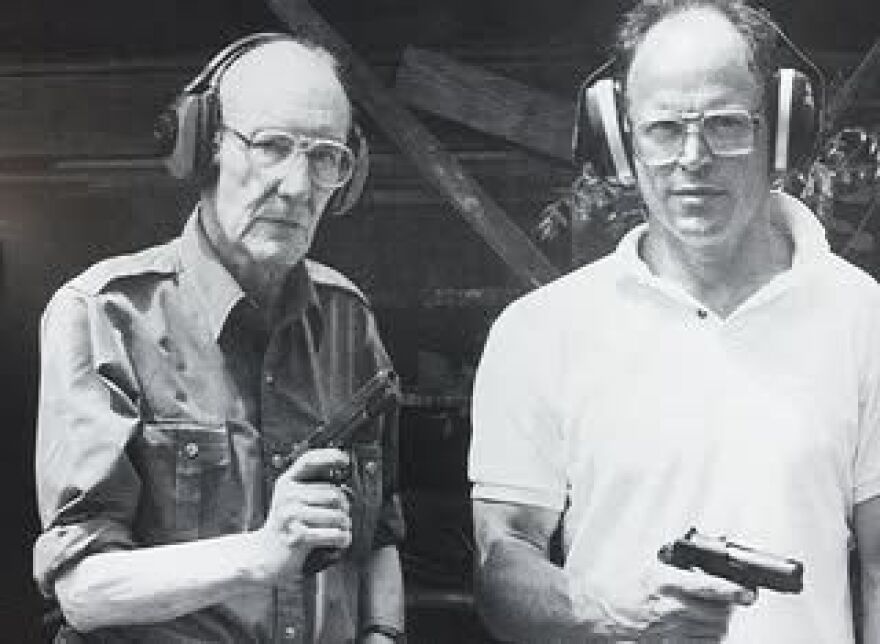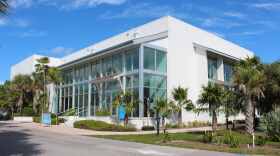Adrien Brody won a Golden Globe for Best Performance by a Male Actor in a Motion Picture Drama on Sunday, but Daniel Craig was nominated in that category for his performance in “Queer,” a film that’s based on a semi-autobiographical novella by William S. Burroughs. A new exhibition at the Bob Rauschenberg Gallery at Florida SouthWestern State College features the man Time Magazine once called “one of the most influential figures in literature.”
“William Burroughs was sort of the person that [Jack] Kerouac and Allen Ginsberg and the so-called Beats most revered,” said Bob Rauschenberg Gallery Director Jade Dellinger.
Burroughs wrote a number of edgy books, including “Junkie,” “Naked Lunch” and “Queer.” His influence extended beyond literature to music and art.
“He was sort of known with [painter and poet] Brian Gysin for developing this cut-up technique, where he would collage, much like Rauschenberg, cut text and reassemble it,” Dellinger said. “He published three books of collaged writings, essentially, called 'Cut Up Writing.' That influenced people like Paul McCartney of the Beatles.”
In fact, McCartney included Burroughs on the cover of the album “Sergeant Pepper’s Lonely Hearts Club Band.” David Bowie wrote lyrics using Burroughs’ cut-up method. U2 included him in a film, and shortly before he died, Kurt Cobain of Nirvana made a pilgrimage to Kansas to meet Burroughs and cut a track with him.
“His influence in the realm of music is extraordinary,” Dellinger said. “The term ‘heavy metal’ would not exist without Burroughs. Burroughs wrote a book called 'Nova Express.' That book has a character named the heavy metal kid.”
Burroughs' collaborations with painter and sculptor David Bradshaw are the subject of “Propagation.” The exhibition includes a series of 3D works that the two of them created using guns and dynamite.
“They had deep conversations about the idea of a gun as a creative destructive tool, that you could make something beautiful using these explosive, instantaneous and highly dangerous and/or incredibly damaging tools,” Dellinger said.
Stored in Bradshaw’s archives in Vermont since Burroughs’ death in 1997, many of the works included in “Propagation” have not been exhibited before.
According to Dellinger, these works will unquestionably “challenge viewers' perceptions of art, its relationship to life, and the enduring power of creative collaboration.”

MORE INFORMATION:
“Queer” follows a gay, drug-addicted American expatriate writer by the name of William “Bill” Lee who is living in Mexico City in 1954. Daniel Craig’s portrayal of Lee not only garnered a Golden Globe nomination, but also a Critics Choice Best Actor nomination as well.
“Queer” opened in limited release theaters on November 17, 2024. According to “When to Stream,” “Queer” is expected to debut on digital streaming via premium video on demand on Tuesday, January 14 (although A24 has yet to confirm the digital release date).
Movie critic Matt Zoller Seitz, writing for RogerEbert.com: Director Luca Guadagnino included in the film “deliberately anachronistic music choices (including Nirvana needle-drops).” Kurt Cobain credited Burroughs' writings as an influence on his songwriting and reached out to him in 1992 to explore the possibility of a collaboration. They eventually met in Lawrence, Kansas, to produce the song “'The ‘Priest’ They Called Him.”
“David BRADSHAW & William S. BURROUGHS: Propagation” opens at the Bob Rauschenberg Gallery at FSW with a 6-8:30 p.m. reception on Saturday, January 18, with an ArtSPEAK@FSW lecture/Q&A by David Bradshaw at 6:30 p.m.
The exhibition runs through April 12, 2025. It will be the final exhibition in the Bob Rauschenberg Gallery for approximately two years as the Humanities Building undergoes a $14 million renovation.
The exhibition is an extension of the Bob Rauschenberg Gallery’s “William S. BURROUGHS & Laurie ANDERSON: Language is a Virus” exhibition, which closed December 7, 2024.
“Both Burroughs and David Bradshaw were close collaborators and dear friends of Bob Rauschenberg, so they make sense in our context,” said Dellinger. “And, in fact, Burroughs made prints in our building at the point we were constructing Humanities Hall in 1979.”
According to Dellinger, David Bradshaw (b. 1944) is a Vermont-based painter, sculptor and marksman best known for his use of handguns, explosive devices (typically dynamite) and steel to create large-scale, free-standing sculptures – profoundly and often elegantly reshaping metal through the brute and expansive force of controlled explosions.
Following studies at the Hartford Art School and extensive involvement with U.S. civil rights activism in the 1960s, Bradshaw moved to New York City, where he participated in various dance and performance art pieces with Deborah Hay, Steve Paxton, Trisha Brown, La Monte Young and Yvonne Rainer. He also frequently exhibited in the ensuing decades with close associates, collaborators and longtime friends including Richard Serra, Laurie Anderson, Eva Hesse, Tina Girouard, Bruce Nauman and Gordon Matta-Clark.
One of the first artists invited by Bob Rauschenberg to work in-residence as a guest at his Untitled Press on Captiva Island, Bradshaw experimented with master printer Robert Petersen on screen-printed, gunshot, hand-annotated and editioned “bullet hole” series prints during months-long stays in 1972 and ‘73.

Having a significant influence on the development and direction of William Burroughs’ own visual art practice, David Bradshaw collaborated extensively and regularly with Burroughs from 1981 until Burroughs’ death in 1997. As one of the pall bearers at Burroughs' funeral, Bradshaw placed Burroughs' favorite pistol in his hand prior to burial.
Bradshaw and Burroughs’ collaborations included a series of cut-out steel “Tin Man” silhouettes, numerous target paintings on canvas and a book/portfolio of prints published by the University of South Florida’s Graphicstudio titled “Propagation Hazard” (1993) – all shot and signed by both artists.
Featured in the “Ports of Entry” retrospective of William S. Burroughs at the Los Angeles County Museum of Art in 1996, David Bradshaw’s work is in the permanent collections of the National Gallery of Art/Washington D.C., Smithsonian Institution, Walker Art Center, Whitney Museum of American Art and Stedelijk Museum/Amsterdam. His work is in the private/estate collections of both Robert Rauschenberg and William S. Burroughs.
According to the Bob Rauschenberg Gallery syllabus for the exhibition, William S. Burroughs (1914-1997), was a key, frequently controversial figure of the Beat generation. Born into wealth and Harvard-educated, Burroughs led an otherwise unconventional life and explored themes of addiction, consciousness, social control and the darkest aspects of the human condition through his widely-influential books including “Junkie” (1953), “Naked Lunch” (1959 — deemed by Time to be one of the top 100 English novels of all time), “The Nova Trilogy” (1961–1964), “Cities of the Red Night” (1981), “The Place of Dead Roads” (1983) and many others.
Burroughs’ novels, novellas and short story collections shocked audiences with their explicit content, dark humor and fractured narratives, often reflecting his experiences on the fringes of society.
Elected to the American Academy and Institute of Arts and Letters and awarded the Ordre des Arts et des Lettres by France, William Burroughs was — according to Jack Kerouac — the "greatest satirical writer since Jonathan Swift,” while Norman Mailer declared him "the only American writer who may be conceivably possessed by genius."
Dellinger chose the title “Propagation” for the exhibition in recognition of the fact that Burroughs was often accused of circulating harmful messages, dangerous ideologies or even viruses.
“The propagation of ideas, form and self are core themes, but so is the challenging of societal norms and the confronting of personal demons,” said Dellinger.
“Examining how ideas are disseminated and transformed through various mediums, the featured works in “David BRADSHAW & William S. BURROUGHS: Propagation” demonstrate how these two artists utilized unconventional methods and chance-based operations to generate new artistic forms and to challenge outdated modes of expression. The use of nontraditional art materials — found objects, industrial detritus and even firearms — highlights their interest in subverting conventional studio practice and standard artmaking processes.
According to David Bradshaw: “In dynamite blasting, ‘propagation’ is the sympathetic detonation of powder out of sequence, resulting in an ‘instant’ (or the accidental total charge mass of explosives firing at one instance when ‘timed’/synchronized detonations were intended).”
Burroughs’ infatuation with firearms and explosives (some label it as a “fixation”) had tragic overtones.
In the late months of 1949, Burroughs evaded gun and drug charges in New Orleans by moving with his wife and children to Mexico City, where he planned to study while waiting out the statute of limitations on his crimes. Instead, he lapsed into the throes of addiction, with heroin and peyote being his drugs of choice.
On September 6, 1951, the couple joined their usual coterie of literary drunks on a stormy evening in an apartment above the rowdy bar they frequented. Divergent stories propagated about what happened next.
“Either high and/or drunk, his wife at the time, Joan Vollmer, challenged him to play William Tell, and she took her drink of gin and she put it on her head and she challenged him to shoot it off with his revolver,” Dellinger explained. “Burroughs took the dare, the bet, and killed his wife accidentally at this party.”
Others maintain that it was Burroughs who, producing a Czech-made Star .380 pistol from his travel bag, announced, "It’s time for our William Tell act.” According to this account, Burroughs directed Vollmer to place the glass on her head, but instead of hitting the glass, the bullet struck her in the temple.
Whether Burroughs or Vollmer initiated the dare, Burroughs used the tragedy as impetus to become one of the most influential figures in American literature.
“It forever changed his life,” Dellinger observed. “It was the worst decision he had ever made. He couldn’t possibly make up for having made that decision and he felt as if he had been possessed on some level. It became the impetus for his creating from then on.”
“I am forced to the appalling conclusion that I would have never become a writer but for Joan’s death,” he famously wrote in the introduction to “Queer.” “The death of Joan brought me into contact with the invader, the Ugly Spirit, and maneuvered me into a lifelong struggle, in which I had no choice except to write my way out.”
Instead of swearing off firearms, “what Burroughs did was become deeply fascinated by guns,” Dellinger added.
While Burroughs credited his wife's death as his inspiration and the impetus for his career, he never gave her a proper burial. To the contrary, her body remains in a pauper’s grave on the edge of Mexico City to this day.
The Bob Rauschenberg Gallery was founded as The Gallery of Fine Art in 1979 on the Lee County campus of Florida Southwestern State College/FSW (then Edison Community College). On June 4 2004, the Gallery of Fine Art was renamed the Bob Rauschenberg Gallery to honor and commemorate the gallery’s long-time association and friendship with the artist. Over the ensuing three decades prior to his death, the Gallery worked closely with Rauschenberg to present world premiere exhibitions including multiple installations of the “¼ Mile or Two Furlong Piece.” The artist insisted on naming the space the Bob Rauschenberg Gallery (versus the “Robert Rauschenberg Gallery”) as it was consistent with the intimate, informal relationship he maintained with both our local Southwest Florida community and FSW.
Gallery hours are Monday - Friday from 10 a.m. to 4 p.m. and Saturday 11 a.m. to 3 p.m.
For more information, telephone (239) 489-9313 or visit www.RauschenbergGallery.com.
Support for WGCU’s arts & culture reporting comes from the Estate of Myra Janco Daniels, the Charles M. and Joan R. Taylor Foundation, and Naomi Bloom in loving memory of her husband, Ron Wallace.







